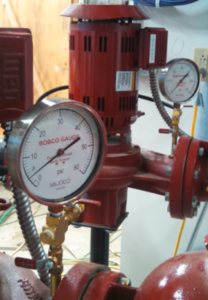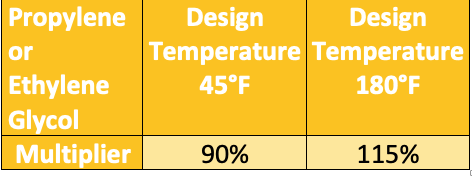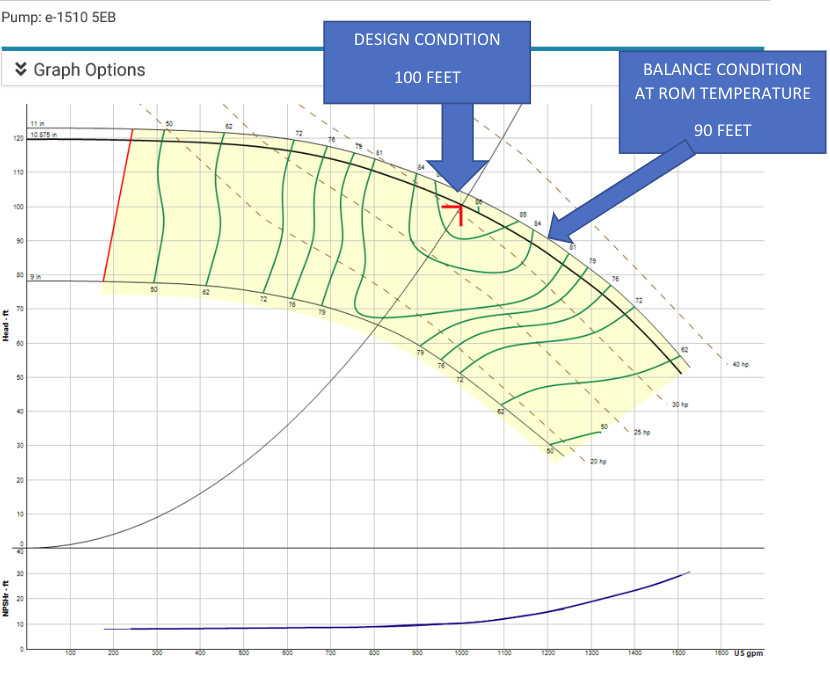Glycol correction factors were the subject of many of the last few R. L. Deppmann Monday Morning Minutes. While writing these articles, I thought about the test and balance contractors’ challenges when it comes to the hydronic pump settings in a chilled water pumping system. The system is likely not at design temperature when balancing the system. Because of this temperature, there is a twist worth knowing.
The challenge occurs because we are typically balancing these hydronic glycol systems at room temperature and the chiller or boiler is normally not in operation. The readings and how you set up the pump may make a difference depending on the temperature and percent of glycol in your system.
Correction Factors for Setting the Pump when the System Contains Glycol
There is a lot of variability with glycol pressure drop corrections in hydronic systems. They vary based on the percentage of glycol, type of glycol, and temperature. To get close enough, I recommend the following:
When setting the pump at room temperature, set the pump at the design head corrected by the multiplier above. This will result in a flow rate greater than design in chilled systems and less than design in heating systems until the design operating temperature is established.
Example: Assuming the Design is 1000 GPM at 100 feet of head
Let’s assume the capacities in the example are for a 40% propylene glycol system designed at 45°F. If we are balancing the pump at room temperature, 100 feet would not be the correct head. Since the pressure drop in the system is smaller at 70°F than it will be at 45°F, we would set the pump at a lower pressure drop and allow it to back up the curve to the design GPM at the design temperature.
In this chilled water example, the design is 100 feet. We would use 0.9 from the chart above and set the pump for 90 feet instead of 100 feet. As the glycol chills, the pressure drop will rise, and the flow rate will drop to the correct design condition.
If it was a heating system, we would set the head at 115 feet when fluid was at room temperature and look for the correct flow when fluid temperature is at design. In either case, don’t forget to apply the correct multiplier to the conversion of PSIG to feet as discussed in the article, Centrifugal Pump Gauge Readout Corrections for Hydronic Glycol Systems.
Do I Need to Correct the Terminal Balance Numbers?
ASHRAE recommends and most specifications require “proportional balancing” methods rather than “read and set” methods. The terminals are in proportion to each other and as the flow rises and falls, the terminal flow rate will follow. When the pump flow rate is set, all the terminal units will also be set. For this reason, the balance contractor does not have to make the adjustment mentioned above at the terminal units.
The Reasons: HVAC Glycol and Water Pump Operation and Temperature
In a past blog called Piping Pressure Drop Correction Factors when using Glycol in Hydronic HVAC Systems, I outlined the large difference in pressure drop depending on the temperature of the glycol. One example I used showed a 32% increase in pump head using 40% propylene glycol at 45°F instead of water. How much difference is there if I compare the pressure drop of 40% propylene glycol at 70°F with that of 45°F? In the article you will see that the pressure drop in 4” pipe at 267 GPM was 5.28 feet/100 at 45°F. If I use the Bell & Gossett System Syzer, I can see the pressure drop changes to 4.68 feet/100 at 70°F. This is a drop of about 11.5% in the pump head. The correction varies with the friction loss and the collective effect of pipe diameters in the system. I chose 10% as a number that gets us a couple of percent off one way or the other. Close enough for what we do.
The heating correction is slightly larger but 15% again gets us in the correct range of flow at design. Finally, if the design temperature is closer to room temperature, such as a heat pump loop, there is no correction needed.
Try it on Your Next project
Whether you balance systems for a career or are just troubleshooting a project, the last three R.L. Deppmann Monday Morning Minutes will assist you in getting numbers and readings accurate. Go ahead and try these small corrections on your next project. Take a set of readings at room temperature and read out the system in full heat or cool when the system is close to design temperatures. You will see a difference.
R. L. Deppmann is always ready to assist their customers, including engineers and balance contractors, with training programs. Visit our Education page or call your salesperson for more information.




